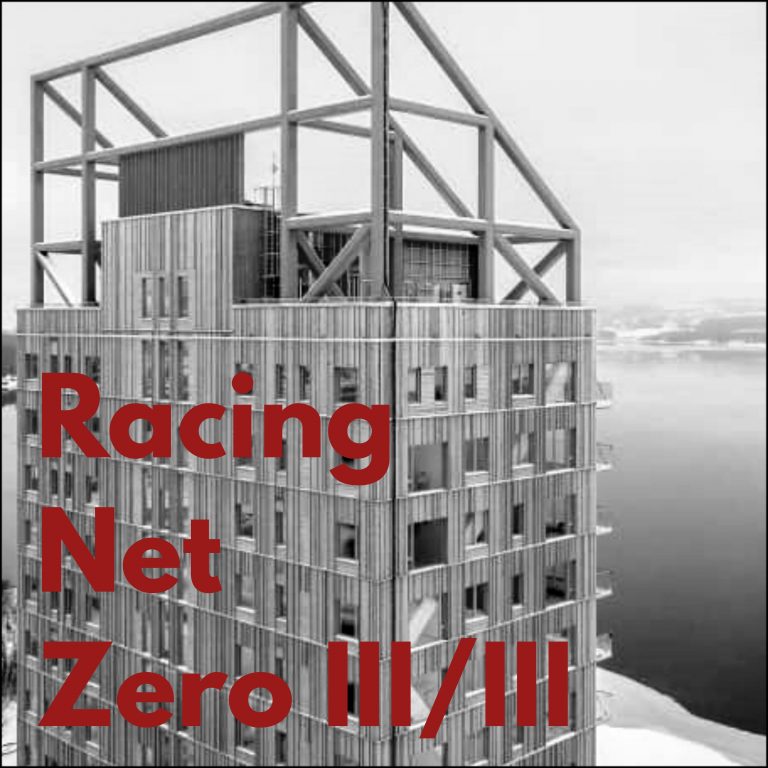Construction alone accounts for 40% of global energy-related carbon dioxide (CO2) emissions. As the global push to reach Net Zero gains momentum, bio-based buildings are seeing a renaissance with mass timber being touted as a key solution to accelerate the transformation of construction towards carbon neutrality.
At Broadpeak, we collaborate with industry experts, impact-driven investors, and academic institutions to address urgent global challanges. Through our articles and trilogies, we aim to share the insights we have gained from these projects with our network. Explore all of our published articles and trilogies in the blog section of our website.
The ultimate Carbon Capture Technology?
Mass timber, also known as engineered wood, is a collective term for large engineered timber elements such as Cross Laminated Timber (CLT) panels. CLT is a prefabricated, solid-engineered wood panel that can be used to build medium to high-rise buildings in a short time, reducing construction time by up to 50% compared to traditional buildings. Currently, the tallest timber building in the world, Mjostarnet, is about 85 meters tall and has 18 floors.
In an exchange with Broadpeak, Frank Vasek, Head of Carbon Solutions at Timber Finance, said, “In the last 10 to 15 years, the timber industry has grown significantly and with new innovative technologies, we can now build timber buildings up to 100 meters and higher. Moreover, mass timber has the potential to play a key role in meeting the Net Zero goal by removing carbon from the atmosphere and storing it long-term.”
Buildings using mass timber can help offset the negative impacts of urbanization by replacing concrete and steel urban houses. According to Abhijeet Mishra, Associate Research Fellow at Potsdam Institute for Climate Impact Research (PIK), “Urban homes made out of wood could play a vital role in climate change mitigation due to their long-term carbon storage potential.”
Wooden buildings hold great potential for becoming long-lasting carbon sinks. The findings of a study conducted by PIK suggest that building future cities from engineered wood could prevent 106 billion tons of CO2 from entering the Earth’s atmosphere by 2100. Similarly, in Europe, wooden buildings have the potential to store 420 million metric tons of CO2 over the next 20 years. This is equivalent to emissions from 108 coal plants in a year. Another study found that substituting wood for conventional building materials reduces emissions by 69% and using wood in half of the new urban construction may achieve 9% of 2030 emissions goals.
In addition to the carbon mitigation factor, there are other benefits such as circularity and well-being that can be achieved using mass-timber buildings. In terms of circularity, mass timber sourced from sustainably managed forests is double circular. During the lifetime of several wood lives (more than 100 years), the softwood trees grow back at least two times in sustainably managed forests, providing a surplus of wood for applications besides construction like paper, textiles, and energy. Moreover, timber buildings fit well in biophilic design practices that have proven to increase productivity and well-being by lowering stress and blood pressure levels.
As the world becomes more ecologically conscious, the revival of wood as a core building material is on the rise. As emissions associated with urbanization continue to rise, governments at all levels are looking for low-carbon alternatives. In the UK, between 15% and 28% of new homes are built using wood annually, capturing over one million tons of CO2 a year as a result. Similarly, carbon-sequestering wood accounts for over 20% of all new multi-floor buildings in Sweden. “Construction from wood will have a big renaissance, especially in Western Europe, as it could be a substantial way to reduce emissions in the construction sector. Already in some areas in Norway, the Netherlands and Switzerland, high skyscrapers are being built using wood,” said development expert Klaus Gihr in an exchange with Broadpeak.
Criticism of a Wooden Future
While engineered wood is gaining traction, there are certain challenges, misconceptions and critiques that hamper its large-scale adoption. Many studies showing a positive climate benefit of mass timber inaccurately assume that using wood is carbon neutral and ecologically sustainable. The foregone cost of carbon that would have been sequestered by the trees if they had not been harvested is rarely taken into account.
Moreover, the conversion efficiency of wood products is very low. John-Rob Pool, Global Implementation Manager, Cities4Forests at World Resources Institute, told us, “When trees are harvested to make wood, sometimes as low as 5-10% of the carbon is stored in building materials while the rest (from roots and slash) is left to decompose, releasing significant amounts of carbon into the air. The conversion efficiency of wooden buildings can therefore oftentimes be very low. For mass timber to be climate beneficial, very high bars must be met.”
Moreover, there is a high risk associated with illegal logging and deforestation calling into question the sustainability of wooden buildings. If wood is not sourced from sustainable, responsibly managed forests, any benefit derived from the building itself would be offset by increased deforestation and habitat loss. Praveen Gupta from the Chartered Insurance Institute told us, “There is no denying that wood is a great solution for carbon mitigation. However, construction is a hungry monster. Take for instance the pristine forests in India and Myanmar which are currently under serious attack. The famed Burma teak finds its way into the US and Europe via India. Likewise, recent investigations have revealed what a sham green certification is. Unless the widespread greenwashing is brought under control, we will have no ancient forests left.”
Along with genuine concerns and challenges, there are also many misconceptions and prejudices about timber building that need to be addressed. Many people still believe that tropical deforestation is linked to timber buildings when it is actually due to agricultural practices. “People have no idea that mass timber in Europe comes from sustainably managed production forests, mostly with FSC and PEFC certification,” explained Pablo van der Lugt, Board Member at Built by Nature.
Moreover, detractors argue that wood is not as strong or safe as concrete. In reality, wooden buildings made using CLT are equally, if not more, robust, safe and fire-resistant than concrete buildings. “Many people are afraid of fire hazards when it comes to wooden buildings. Tests have shown however that wood is a robust construction material with few fire risks,” said Gihr.
How to scale Low-Carbon Construction?
To scale low-carbon construction, we need efficient policy frameworks and government support to mobilize private capital, achieve standardization, and ensure sustainable forestry. Policy actions such as including mass timber in carbon offset crediting programs, third-party verification for sustainable forest management and standardizing CLT production can incentivize the adoption of mass timber.
“Mass timber from sustainably managed forests is one of the most efficient carbon removal solutions. However, due to little awareness regarding its climate potential and lack of timber know-how, it is often overlooked by investors. New climate strategies and policies need to acknowledge timber construction as a scalable carbon removal solution. This will be crucial in driving new funds and capital into the entire timber industry and closing the existing investment gap,” explained Vasek.
Moreover, building codes and regulations that disadvantage light building methods such as mass timber need to be adapted as well. Additionally, there is a need to put in place effective wood management policies that ensure proper recycling of wood at the end of its life to prevent carbon from being released. “Strong governance and careful planning are required to limit negative impacts on biodiversity and to ensure a sustainable transition to timber cities,” said Mishra.
We also need to invest more in research and development to truly understand and enhance the efficiency and mitigation potential of wooden buildings. Conversion efficiency must be improved while the amount of biomass residue that is left over in the forests to decompose must be reduced significantly. In addition, it’s vital to ensure that the supply of wood is sustainable – wood must be sourced from sustainably managed and certified forests to prevent the risk of illegal logging and deforestation. “We need to invest more in research and development to come up with innovative solutions to tackle challenges associated with timber buildings for it to become truly effective in mitigating climate change,” stressed Gihr.
Van der Lugt provides a succinct outlook: “We need to show that mass timber buildings are not only a climate solution, they are also healthy and cool. In a similar way, the electric cars image has shifted from being high-end to mainstream. The same needs to happen with mass timber buildings. And it will. But for this, we need to keep informing the audience through smart, targeted communication campaigns — design competitions, demonstrations, documentaries — reaching the right target groups.”





